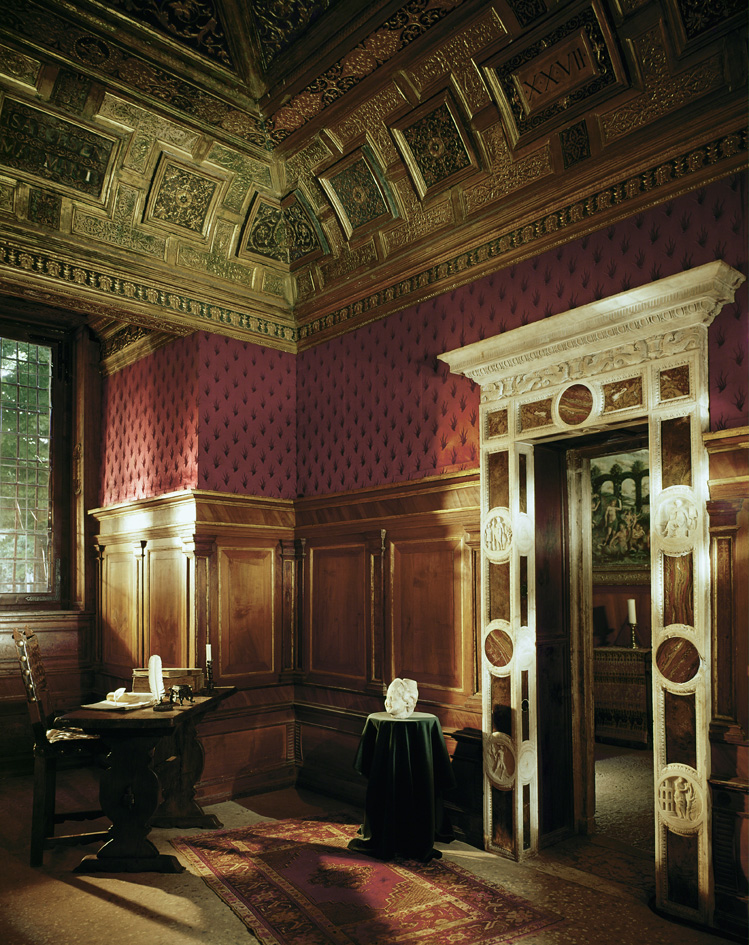“We are glad to hear that you are doing your utmost to finish our studiolo, so as not be sent to prison . . . you can paint whatever you like inside the cupboards, as long as it is not anything ugly, because if it is, you will have to paint it all over again at your own expense.”
—Isabella d’Este to a Mantuan artist5
Perhaps this imperious letter from Isabella d’Este is not an entirely fair representation. She was also capable of cajolery and flattery to advance her collecting ambitions, and many patrons expressed similar complaints about slow performance. Isabella had been married at age seventeen to Ludovico’s grandson Francesco Gonzaga. While her husband devoted his energies to military endeavors, she deployed culture and the arts as a way to expand the prestige of their small state. Isabella became one of the most energetic, knowledgeable, and committed of all Renaissance patrons. We know a lot about her collecting because she left an extensive record of her dealings with agents and artists in her correspondence. More than 12,000 of her letters survive. She archived them, as if with an eye to posterity.
Isabella was the favorite of her father, Ercole d’Este, and acquired a good education in Ferrara, along with a devotion to dance and music (she was an accomplished player of the lira da braccio, a bowed string instrument). She studied Latin with Mario Equicola (discussed later), but apparently had little success. Instead, she diverted her interest in the classics into a passion for antiquities. She described herself as having an “insatiable desire” for old things, amassing ancient coins, medals, engraved gems, and statuettes. Her collecting zeal was such that a fellow aristocrat jokingly warned she was in danger of becoming more like a merchant than a lady. One of her early personal emblems was a magnet. At a time when most women commissioned only religious works, Isabella stood out as a female collector of antiquities. An inventory made after her death listed more than 1,500 items, mainly coins and medals but also 72 vessels and 40 engraved gems.
Artists were often called on to provide expert advice in the purchase and restoration of antiquities. Helping Isabella were Mantegna, who had made a serious study of ancient art and architecture, and court sculptor and architect Gian Cristoforo Romano. In addition to creating several medals for his classically minded patron based on antique models, Gian Cristoforo helped Isabella circumvent papal restrictions on the export of antiquities. She acquired a statue of Cupid believed to have been made by the great ancient Greek sculptor Praxiteles. She obtained a bust of the Roman empress Faustina from Mantegna by assuming a debt he was unable to repay. Her interest in ancient art also led Isabella to employ Pier Jacopo Alari Bonacolsi, called Antico. Like the others, he advised on ancient art and made restorations, but he also created small bronze replicas of famed ancient statues and original works that evoked the style and subjects of classical sculpture (see Antico).
Medal of Isabella d’Este
On the front of this medal, Isabella is named and identified as the marchesa of Mantua. On the reverse, signs of the zodiac are accompanied by a Latin inscription: BENEMERENTIUM ERGO (For those who are well deserving). She gave copies of the medal to favored courtiers and presented them as diplomatic gifts. It was said that when the ladies at the court of Naples received one of Isabella’s medals, they kissed it. A sonnet was even composed in its honor. Isabella had Gian Cristoforo make a version of the medal in gold, set with jewels. This one she kept in her grotta, displayed next to an ancient cameo.
Isabella kept her antiquities in the grotta, a vaulted ground-floor room that was directly below her studiolo. Planning for these spaces started soon after her marriage, and work on them continued for twenty years. When her husband died and she moved to another part of the palace complex, she reestablished both grotta and studiolo in her new residence.
Grotta of Isabella d’Este
The rooms of Isabella’s first grotta and studiolo in the Castello di San Giorgio still exist, but the reconstructed rooms in this photograph are her later rooms in the Corte Vecchia. The view here is from the grotta, looking into the adjacent studiolo, where a copy of Mantegna’s Pallas and the Vices is just visible. Both the Castello and the Corte Vecchia were part of the complex of buildings that made up the ducal palace, and they may be visited today.

Andrea Mantegna
Pallas and the Vices (Minerva Expelling the Vices from the Garden of Virtue), c. 1499–1502
Oil on canvas, 159 x 192 cm (62 3/5 x 75 3/5 in.)
Musée du Louvre, Paris
Scala/Art Resource, NY
The meaning of Mantegna’s first painting was perhaps deliberately obscure, but here we find Athena, goddess of wisdom and the arts—and surely a stand-in for Isabella herself—unambiguously rushing to vanquish the base and irrational.
To decorate the studiolo, Isabella envisioned a set of paintings on classical and allegorical themes. Their mythological subjects, like her antiquities, were an unusual departure for a female patron. Nevertheless, she wanted something with “fine meaning,” she said, and the paintings’ pagan subjects are tempered with moralizing intent. While their interpretation continues to invite speculation, Isabella’s motivation as a patron seems clear: she was “collecting” the work of modern artists. She wrote frankly to her agent that she wanted works by the best artists in Italy; she hoped the artists would be driven by competition with each other to produce the best they were capable of doing.
Four Women Dancing
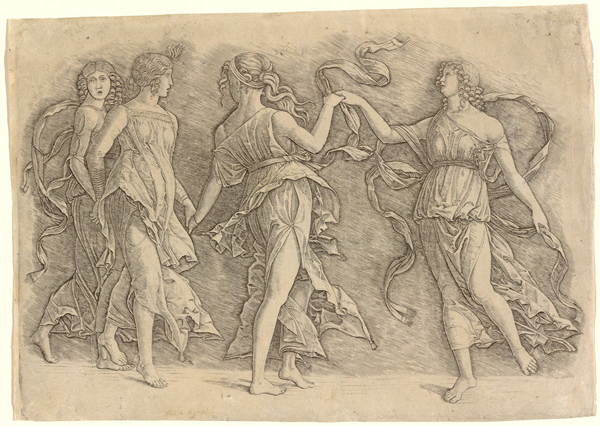
Workshop of Andrea Mantegna or Attributed to Zoan Andrea
Four Women Dancing, c. 1497
Engraving, 24.3 x 35 cm (9 9/16 x 13 3/4 in.)
National Gallery of Art, Washington, DC, Rosenwald Collection
Image courtesy of the Board of Trustees, National Gallery of Art
In Mantegna’s Parnassus, Mars and Venus, parents of Cupid, stand like statues on an arch above a gathering of other gods and dancing muses. The sinuous, moving line of the dancers was the only motif from any of the paintings in Isabella’s study to be reproduced in prints.
She turned first to the elderly Mantegna, who presented her with Mars and Venus, traditionally called Parnassus, in 1497. It was several years later (and not long before his death), in 1502, that his second painting, Pallas and the Vices, was completed. In the meantime, Isabella sought contributions from others, including Raphael and Leonardo; the latter declined the commission even though she offered him free rein to choose his subject (he did draw her portrait). She also contacted Giovanni Bellini, the preeminent painter in Venice (and Mantegna’s brother-in-law). Bellini balked at the detailed instructions he was given and also refused the commission. Pietro Bembo, acting as Isabella’s agent, explained that Bellini “does not like to be given many written details, which cramp his style, his way of working, as he says is always to wander at will in his pictures, so that they can satisfy him as well as the beholder.”8 Isabella remained intent on owning a painting by the Venetian master, and Bellini was able to persuade her to accept a small Nativity, which she hung in her bedroom. Earlier she had sought a work from Giorgione and tried to obtain a nocturne (night scene) after his death. Her agents identified two candidates, but their owners were loath to part with them.
Leonardo’s Portrait of Isabella d’Este
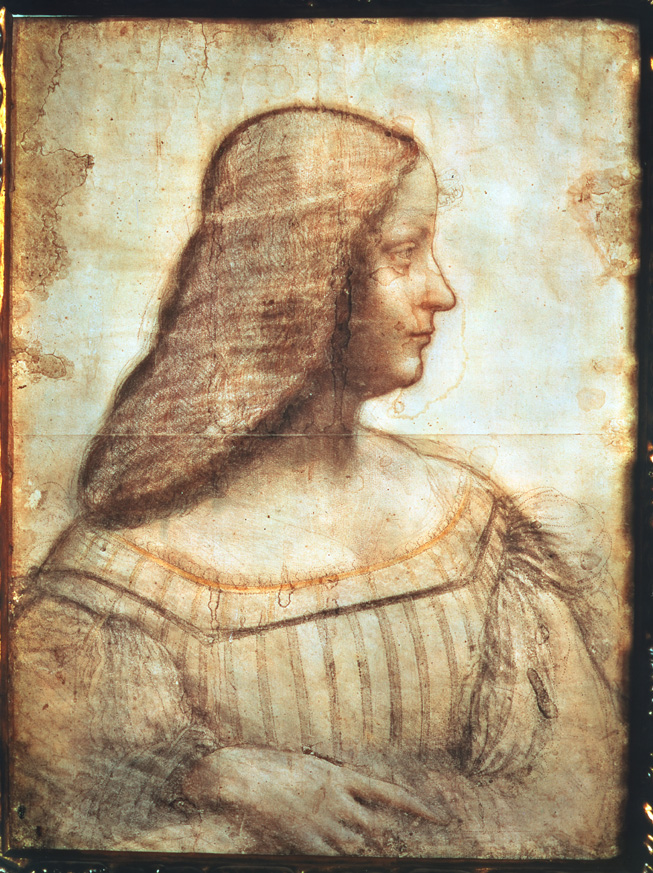
Leonardo da Vinci
Portrait of Isabella d’Este, 1519
Red, black, ocher, and white chalk drawing, 46.5 x 61 cm (18 1/2 x 24 in.)
Musée du Louvre, Paris
Scala / Art Resource, NY
Isabella cast far and wide for a portraitist who would flatter her rather plump figure. She had complained of one likeness that she said “makes me look fatter than I am.”9 She admired a portrait Leonardo painted for her brother-in-law in Milan (it showed his mistress) and hoped the artist would paint her as well. Her chance came when Milan was invaded by French troops and Leonardo spent a short time in Mantua. His preparatory drawings apparently pleased her. This cartoon, which has been pricked to allow the image to be transferred, was originally longer and included Isabella’s hands holding a book—she wished to be appreciated for her learning as well as her looks. Over a period of four years she waited for Leonardo to complete a painting, but he never did. Finally, she suggested that Leonardo paint an image of the young Christ for her instead (see “Isabella d’Este asks Leonardo for a work”). Several paintings of Isabella are known today, including one by Titian; all are very flattering.
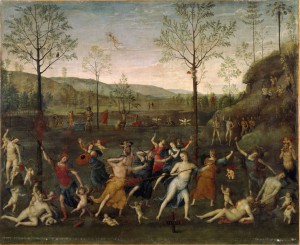
Attributed to Perugino
The Battle of Love and Chastity, 1503
Oil on canvas, 160 x 191 cm (63 x 75 1/5 in.)
Musée du Louvre, Paris
Isabella turned next to Perugino. Negotiations with him continued for ten years and are documented in more than seventy letters. The contract also survives. When Isabella’s agent worried about the choice of Perugino—he was advanced in age and his style already somewhat outdated—Isabella replied confidently that he would want to measure up to Mantegna. The instructions conveyed to Perugino were very explicit (see “Isabella instructs Perugino”). Isabella had worked out overall schemes and detailed narratives (fantasia) with her literary advisor, poet and scholar Paride da Ceresara (1466–1532). When the painting was delivered, she complained that the figure of Athena had been painted nude, contrary to her instruction. She supposed, she said, that painting a nude provided Perugino a better way to show his excellence as a painter. Surviving documents do not indicate that Mantegna received the same specific direction from Isabella, but Mantegna was in Mantua, where he could have met with her in person to discuss the program.
Two more paintings for Isabella’s studiolo were supplied by Lorenzo Costa, an artist from Ferrara who succeeded Mantegna at court. An allegory, variously titled, apparently shows Isabella herself being crowned as a winning poet. Costa also completed a work that had been begun by Mantegna but was unfinished at the time of his death. All the studiolo paintings celebrated the arts and Isabella’s own role as a promoter of culture and creativity, but they also dealt with themes of virtue and vice. Her own virtue was clearly implied. For her second studiolo, where she had space to accommodate two additional pictures, she commissioned allegories from Correggio that were more directly moralizing.

Antico
Seated Nymph, probably 1503
Bronze with gilding and silvering, h. without base 19.5 cm (7 5/8 in.)
Robert H. and Clarice Smith
Antico, whose nickname proclaims his interest and reputation, worked for the Gonzaga most of his life. He had probably been trained as a goldsmith, a background evident in the gilded and silvered details that enliven and enrich his small bronzes. Antico’s first great patron, Ludovico Gonzaga (the uncle of Isabella’s husband), wrote her: “Because Antico is singularly loved by me not only for his many years of service to this household, but also for the unanimous affection that we all have for him because of his virtue and good disposition, I beg Your Excellency that, like myself and all of us here, she will love him and hold him dear and favored.”6 It seems that she did. When Antico’s family’s license as meat-sellers in the town market was in jeopardy, Isabella likely intervened (probably not coincidentally after the artist had completed a requested work in record time). She also arranged the marriage of Antico’s daughter.
Antico’s small-scale bronzes, many of them made for Isabella, were among the first bronze statuettes known to reproduce (on a small scale) the important classical sculptures that were being excavated in Rome. He can be credited as much as any other artist with encouraging the development of small bronzes, despite the fact that his production was small and limited mostly to courtly patrons. Antico seems also to have reintroduced the ancient method of indirect bronze casting, by which the original model was preserved and could be used for multiple castings.
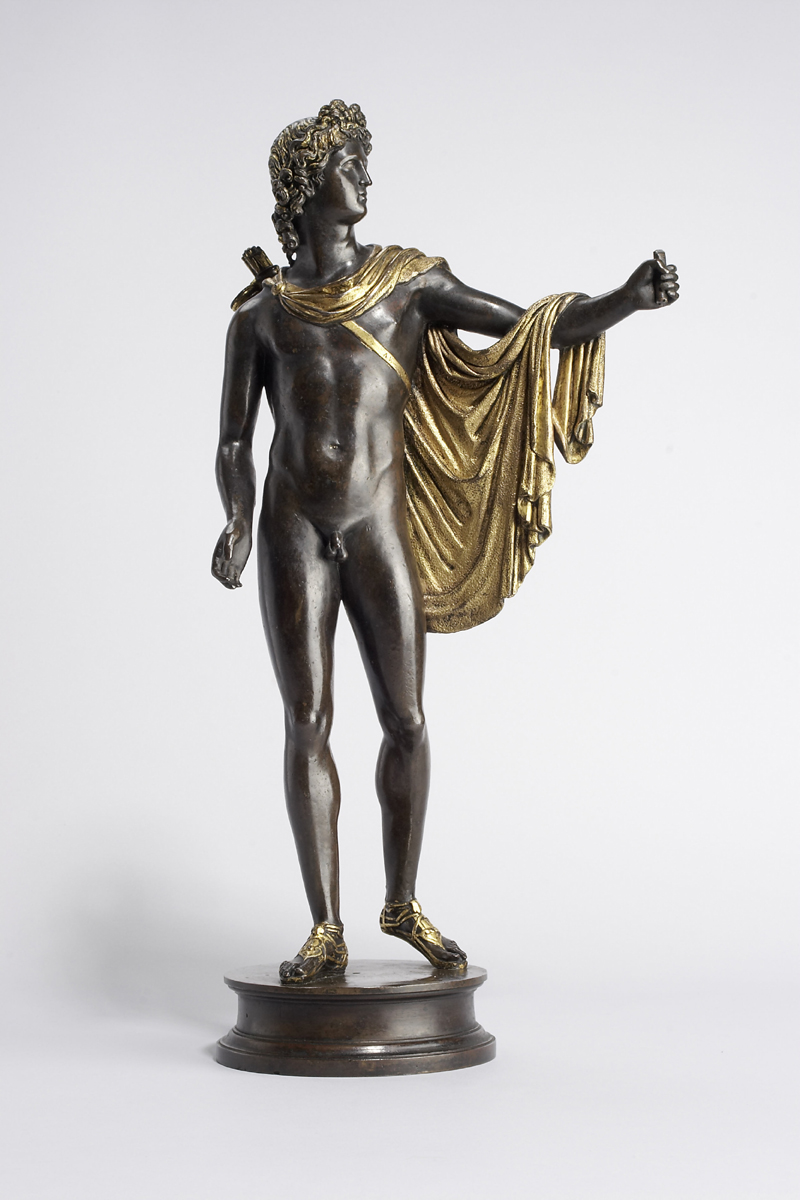
Antico
Apollo Belvedere, 1497–8
Bronze, partly gilded, eyes inlaid in silver, h. 41.3 cm (16 1/4 in.)
Leibieghaus Skulpturensammlung, Frankfurt
© Liebieghaus Skulpturensammlung/ARTOTHEK
A large marble statue was discovered in Rome in 1489. By 1511 it had been installed in the Cortile del Belvedere (courtyard) in the Vatican, where its fame grew. The statue came to be called the Apollo Belvedere. It was long thought to be a Hadrianic copy of a Hellenistic bronze, but many scholars today see it as an original Roman creation. Antico replicated it in bronze statuettes. Isabella owned one of the Apollo Belvedere statuettes made by Antico, though it may not have been this particular one.
To support the outstretched arm of the god, the marble statue included a support; as in many marble works, it is in the form of a tree stump. Antico entirely eliminated the support because the strength of the bronze made it unnecessary. He perhaps also understood that such a support would not have been part of the ancient bronze original.
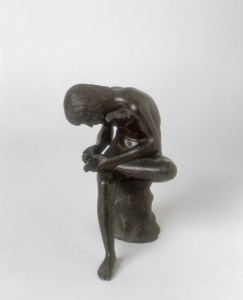
Antico
The Spinario, c. 1499
Bronze with silvering
Galleria Estense, Modena, Italy
Alinari/Art Resource, NY
Isabella later requested a companion piece for the Spinario. Antico made several versions of this nymph, and other artists used it as a model. We do not know if this is the statuette owned by Isabella, but the level of its workmanship is very high, worthy of a patron such as the marchesa. The round base of this and many other statuettes by Antico would invite someone to rotate and admire them from all sides.
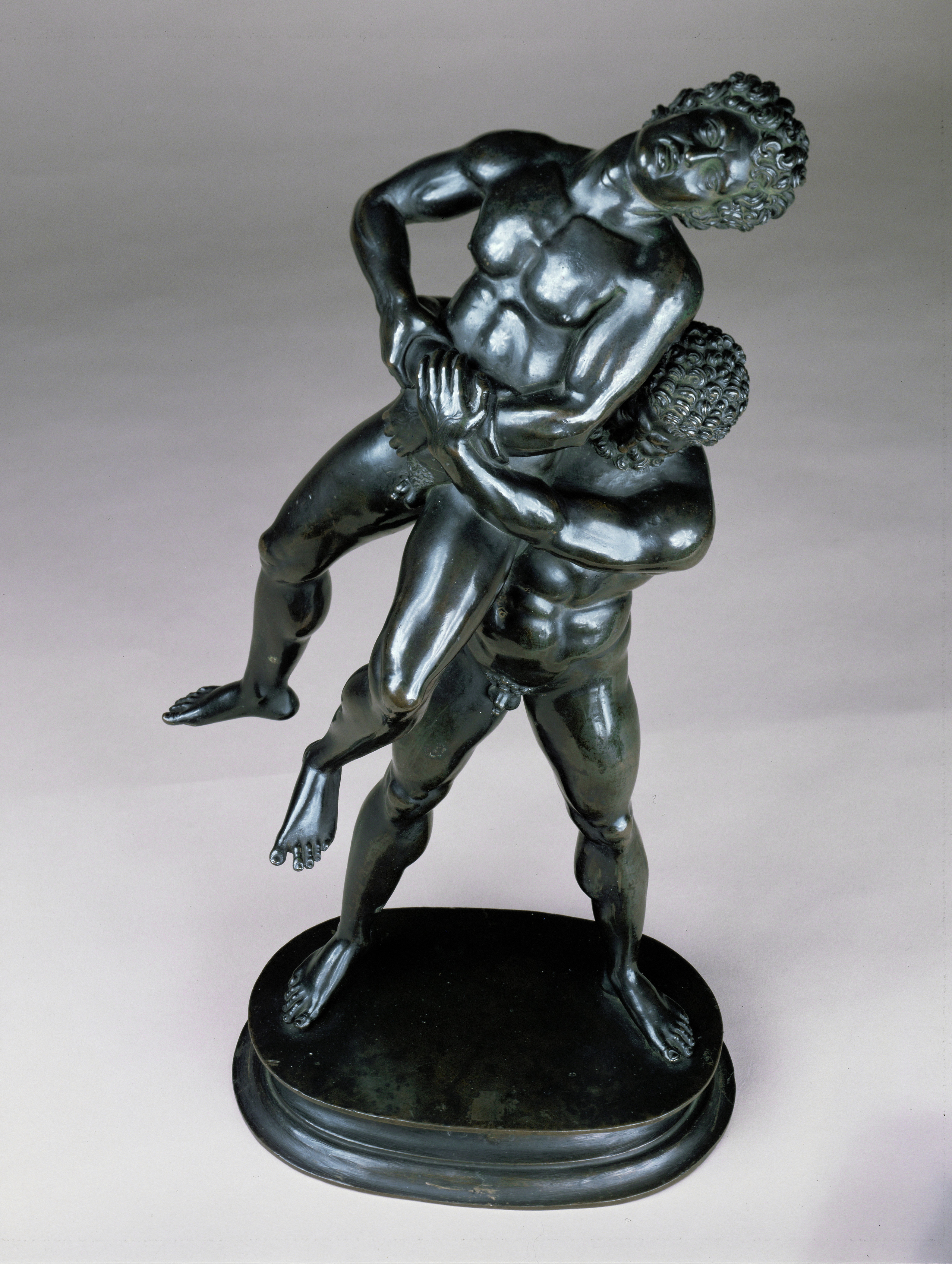
Antico
Hercules and Antaeus, 1519
Bronze, h. with base 39.6 cm (15 5/8 in.)
Kunsthistorisches Museum, Vienna, Kunstkammer
Erich Lessing/Art Resource, NY
This statuette certainly belonged to Isabella, as indicated by the inscription cast inside the base: D / ISABEL / LA / M MAR (the Divine Isabella, Marchesa of Mantua). Antico had earlier made a Hercules and Antaeus for her husband’s uncle, bishop of Mantua. In a letter Antico wrote in April 1519 listing compositions that Isabella might consider commissioning was this one, “the most beautiful antiquity that ever was.”7
The giant Antaeus was a son of the Earth. Because he was continually strengthened by his contact with the ground, he could never be defeated in a fight, until Hercules learned the secret and crushed Antaeus in his powerful grasp while holding him aloft. The challenging composition of the contest between Hercules and Antaeus attracted many sculptors.
![Gian Cristoforo Romano<br /><i>Isabella d'Este, (1474–1539), Wife (1490) of Francesco Il Gonzaga of Mantua</i> [obverse], 1507<br />Bronze, diameter 3.9 cm (1 9/16 in.)<br />National Gallery of Art, Washington, DC, Samuel H. Kress Collection<br />Image courtesy of the Board of Trustees, National Gallery of Art<br />](http://italianrenaissanceresources.com/wp-content/uploads/2013/03/RP_1171-1.jpg)
